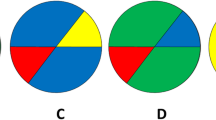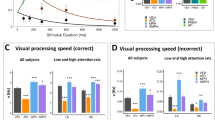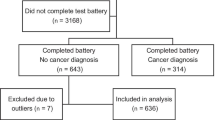Abstract
Introduction
Theory of visual attention (TVA; Bundesen 1990) whole report tasks allow the independent measurement of visual perceptual processing speed and visual short-term memory (vSTM) storage capacity, unconfounded by motor speed. This study investigates how cognitive enhancing effects of psychostimulants depend on baseline performance and individual plasma levels.
Materials and methods
Eighteen healthy volunteers (aged 20–35 years) received single oral doses of either 40 mg methylphenidate, 400 mg modafinil or placebo in a counterbalanced, double-blind crossover design. A whole report of visually presented letter arrays was performed 2.5–3.5 h after drug administration, and blood samples for plasma level analysis were taken.
Results
Methylphenidate and modafinil both enhanced perceptual processing speed in participants with low baseline (placebo) performance. These improvements correlated with subjective alertness. Furthermore, we observed differential plasma level-dependent effects of methylphenidate in lower and higher performing participants: higher plasma levels led to a greater improvement in low-performing participants and to decreasing improvement in high-performing participants. Modafinil enhanced visual short-term memory storage capacity in low-performing participants.
Conclusions
This is the first pharmacological investigation demonstrating the usefulness of a TVA task for high-resolution and repeated cognitive parameter estimation after cognitive-enhancing medication. Our results confirm previous findings of attentional capacity improvements in low performers and extend the baseline dependency model to methylphenidate. Plasma level-dependent effects of psychostimulants can be modelled on an inverted U-shaped dose–response relationship, which is highly relevant to predict cognitive enhancing and detrimental effects of psychostimulants in patients with cognitive deficits (e.g., attention deficit hyperactivity disorder) and healthy volunteers (e.g., self-medicating academics).






Similar content being viewed by others
References
Arnsten AFT, Goldman-Rakic PS (1998) Noise stress impairs prefrontal cortical function in monkeys: evidence for a hyperdopaminergic mechanism. Arch Gen Psychiatry 55:362–368
Ballon JS, Feifel D (2006) A systematic review of modafinil: potential clinical uses and mechanisms of action. J Clin Psychiatry 67:554–566
Baranski JV, Pigeau R, Dinich P, Jacobs I (2004) Effects of modafinil on cognitive and meta-cognitive performance. Hum Psychopharmacol 19:323–332
Barch DM (2004) Pharmacological manipulation of human working memory. Psychopharmacology 174:126–135
Barnett AG, van der Pols JC, Dobson AJ (2004) Regression to the mean: what it is and how to deal with it. Int J Epidemiol 34:215–220
Becker PM, Schwartz JR, Feldman NT, Hughes RJ (2004) Effect of modafinil on fatigue, mood, and health-related quality of life in patients with narcolepsy. Pycholpharmacol 171:133–139
Berridge CW, Devilbiss DM, Andrzejewski ME, Arnsten AFT, Kelley AE, Schmeichel B, Hamilton C, Spencer RC (2006) Methylphenidate preferentially increases catecholamine neurotransmission within the prefrontal cortex at low doses that enhance cognition. Biol Psychiatry 60:1111–1120
Bublak P, Finke K, Krummenacher J, Preger R, Kyllingsbæk S, Müller HJ, Schneider WX (2005) Usability of a theory of visual attention (TVA) for parameter-based measurement of attention II: evidence from two patients with frontal or parietal damage. J Int Neuropsychol Soc 11:843–854
Bundesen C (1990) A theory of visual attention. Psychol Rev 97:523–547
Bundesen C (1998) A computational theory of visual attention. Phil Trans R B 353:1271–1281
Bundesen C, Habekost T, Kyllingsbæk S (2005) A neural theory of visual attention: bridging cognition and neurophysiology. Psychol Rev 112:291–328
Burnat P, Robles F, Do B (1998) High-performance liquid chromatographic determination of modafinil and its two metabolites in human plasma using solid-phase extraction. J Chromatogr B 706:295–304
Camp-Bruno JA, Herting RL (1994) Cognitive effects of milacemide and methylphenidate in healthy young adults. Psychopharmacology 115:46–52
Castner SA, Williams GV, Goldman-Rakic PS (2000) Reversal of antipsychotic-induced working memory deficits by short term dopamine D1 receptor stimulation. Science 287:2020–2022
Clatworthy PL, Lewis SJG, Birchard L, Hong YT, Izquierdo D, Clark L, Cools R, Aigbirhio FI, Baron J-C, Fryer TD, Robbins TW (2009) Dopamine release in dissociable striatal subregions predicts the different effects of oral methylphenidate on reversal learning and spatial working memory. J Neurosci 29:4690–4696
Cooper NJ, Keage H, Hermens D, Williams LM, Debrota D, Clark CR (2005) The dose-dependent effect of methylphenidate on performance, cognition and psychophysiology. J Integr Neurosci 4:123–144
Coull JT, Frackowiak RS, Frith CD (1998) Monitoring for target objects: activation of right frontal and parietal cortices with increasing time on task. Neuropsychologia 36:1325–1334
Courtney SM, Petit L, Maisog JM, Ungerleider LG, Haxby JV (1998) An area specialized for spatial working memory in human frontal cortex. Science 279:1347–1351
Desimone R, Duncan J (1995) Neural mechanisms of selective visual attention. Ann Rev Psychol 18:193–222
Dodds CM, Müller U, Manly T (2009) Effects of psychostimulants on alertness and spatial bias in healthy participants. J Cogn Neurosci 21:529–537
Doerge DR, Fogle M, Paule MG, McCullagh M, Bajic S (2000) Analysis of methylphenidate and its metabolites ritalinic acid in monkey plasma by liquid chromatography/electrospray ionisation mass spectrometry. Rapid Comm Mass Spectrom 14:619–623
Duncan J, Bundesen C, Olson A, Humphreys G, Chavda S, Shibuya H (1999) Systematic analysis of deficits in visual attention. J Exp Psychol: Gen 128:450–478
Eagle DM, Tufft MRA, Goodchild HL, Robbins TW (2007) Differential effects of modafinil and methylphenidate on stop-signal reaction time task performance in the rat, and interactions with the dopamine receptor antagonist cis-flupenthixol. Psychopharmacology 192:193–206
Elliott R, Sahakian BJ, Matthews K, Bannerjea A, Rimmer J, Robbins TW (1997) Effects of methylphenidate on spatial working memory and planning in healthy young adults. Psychopharmacology 131:196–206
Evans SW, Pelham WE, Smith BH, Bukstein O, Gnagy EM, Greiner AR, Altenderfer L, Baron-Myak C (2001) Dose-response effects of methylphenidate on ecologically valid measures of academic performance and classroom behavior in adolescents with ADHD. Exp Clin Psychopharmacol 9:163–175
Farah MJ, Haimm C, Sankoorikal G, Chatterjee A (2009) When we enhance cognition with Adderall, do we sacrifice creativity? A preliminary study. Psychopharmacology 202:541–547
Feola TW, de Wit H, Richards JB (2000) Effects of d-amphetamine and alcohol on a measure of behavioral inhibition in rats. Behav Neurosci 114:838–848
Finke K, Bublak P, Krummenacher J, Kyllingsbæk S, Müller HJ, Schneider WX (2005) Usability of a theory of visual attention (TVA) for parameter-based measurement of attention I: evidence from normal subjects. J Int Neuropsychol Soc 11:832–842
Finke K, Bublak P, Dose M, Müller HJ, Schneider WX (2006) Parameter-based assessment of spatial and non-spatial attentional deficits in Huntington's disease. Brain 129:1137–1151
Foote SL, Morrison JH (1975) Effects of putative neurotransmitters on neuronal activity in monkey auditory cortex. Brain Res 86:229–242
Goldman-Rakic PS (1995) Architecture of the prefrontal cortex and the central executive. Ann NY Acad Sci 769:71–84
Gualtieri CT, Wargin W, Kanoy R, Patrick K, Shen CD, Youngblood W, Mueller R, Breese G (1982) Clinical studies of methylphenidate serum levels in children and adults. J Am Acad Child Psychiatry 21:19–26
Habekost T, Bundesen C (2003) Patient assessment based on a theory of visual attention (TVA). Subtle deficits after a right frontal lesion. Neuropsychologia 41:1171–1188
Halliday R, Callawy E, Naylor H, Gratzinger P, Prael R (1986) The effect of stimulant drugs on information processing in elderly adults. J Gerontol 41:748–757
Hebb DO (1949) Organization of behavior. Wiley, New York
Kimberg DY, D’Esposito M, Farah MJ (1997) Effects of bromocriptine on human subjects depends on working memory capacity. Neuroreport 8:3581–3585
Koelega HS (1993) Stimulant drugs and vigilance performance: a review. Psychopharmacology 111:1–16
Kyllingsbæk S (2006) Modeling visual attention. Behav Res Methods 38:123–133
Larriviere D, Williams MA, Rizzo M, Bonnie RJ, AAN Ethics, Law and Humanities Committee (2009) Responding to requests from adult patients for neuroenhancements: guidance of the Ethics, Law and Humanities Committee. Neurology 73:1406–1412
Matthias E, Bublak P, Müller HJ, Schneider WX, Krummenacher J, Finke K (2010) The influence of phasic alertness on spatial and non-spatial components of visual attention. J Exp Psychol: Hum Percept Perform 33:38–56
McClellan KJ, Spencer CM (1998) Modafinil: a review of its pharmacology and clinical efficacy in the management of narcolepsy. CNS Drugs 9:311–324
Mehta MA, Owen AM, Sahakian BJ, Mavaddat N, Pickard JD, Robbins TW (2000) Methylphenidate enhances working memory by modulating discrete frontal and parietal lobe regions in the human brain. J Neurosci: 20: RC65: 1–6
Midha KK, McKay G, Rawson MJ, Korchinski ED, Hubbard JW (2001) Effects of food on the pharmacokinetics of methylphenidate. Pharm Res 18:1185–1189
Miller EK, Cohen JD (2001) An integrative theory of prefrontal cortex function. Ann Rev Neurosci 28:167–202
Milner AD, Goodale MA (1995) The visual brain in action. Oxford University Press, Oxford
Minzenberg MJ, Carter CS (2008) Modafinil: a review of neurochemical actions and effects on cognition. Neuropsychopharmacology 33:1477–1502
Minzenberg MJ, Watrous AJ, Yoon JH, Ursu S, Carter CS (2008) Modafinil shifts human locus coeruleus to low-tonic, high-phasic activity during functional MRI. Science 322:1700–1703
Müller U, Steffenhagen N, Regenthal R, Bublak P (2004) Effects of modafinil on working memory processes in humans. Psychopharmacology 177:161–169
Müller U, Suckling J, Zelaya F, Honey G, Faessel H, Williams SCR, Routledge C, Brown J, Robbins TW, Bullmore ET (2005) Plasma level-dependent effects of methylphenidate on task-related functional magnetic resonance imaging signal changes. Psychopharmacology 180:624–633
National Institute for Health and Clinical Excellence (NICE) (2008) Attention deficit hyperactivity disorder. Diagnosis and management of ADHD in children, young people and adults. NICE clinical guideline 72. London: NICE
Naylor HN, Halliday R, Callawy E (1985) The effect of methylphenidate on information processing. Psychopharmacology 86:90–95
Posner MI, Petersen SE (1990) The attention system of the human brain. Ann Rev Neurosci 13:25–42
Randall DC, Shneerson JM, Plaha KK, File SE (2003) Modafinil affects mood, but not cognitive function, in healthy young volunteers. Hum Psychopharmacol Clin Exp 18:163–173
Randall DC, Fleck NL, Shneerson JM, File SE (2004) The cognitive-enhancing properties of modafinil are limited in non-sleep-deprived middle-aged adolescents. Pharmacol Biochem Behav 77:547–555
Randall DC, Shneerson JM, File SE (2005a) Cognitive effects of modafinil in student volunteers may depend on IQ. Pharmacol Biochem Behav 82:133–139
Randall DC, Viswanath A, Bharania P, Esabagh SM, Harley DE, Shneerson JM, File SE (2005b) Does modafinil enhance cognitive performance in young volunteers who are not sleep-deprived? J Clin Psychopharmacol 25:175–179
Regenthal R, Koch H, Köhler C, Preiss R, Krügel U (2009) Depression-like deficits in rats improved by subchronic modafinil. Psychopharmacology 204:627–639
Robbins TW, Sahakian BJ (1979) ‘Paradoxical’ effects of psychomotor stimulant drugs in hyperactive children from the standpoint of behavioural pharmacology. Neuropharmacology 18:931–950
Robbins TW, Roberts AC (2007) Differential regulation of fronto-executive function by the monoamines and acetylcholine. Cereb Cortex 17(Suppl 1):i151–i160
Robbins TW, Arnsten AFT (2009) The neuropsychopharmacology of fronto-executive function: monoaminergic modulation. Ann Rev Neurosci 32:267–287
Roberts AOH (1980) Regression toward the mean and the regression-effect bias. In: Echternacht G (ed) New directions for testing and measurement, vol 8. Jossey-Bass, San Francisco, pp 59–82
Robertson P, Hellriegel ET (2003) Clinical pharmacokinetic profile of modafinil. Clin Pharmacokinet 42:123–137
Rocconi LM, Ethington CA (2009) Assessing longitudinal change: adjustment for regression to the mean effects. Res High Educ 50:368–376
Rogers RD, Blackshaw AJ, Middleton HC, Matthews K, Hawtin K, Crowley C, Hopwood A, Wallace C, Deakin JFW, Sahakian BJ, Robbins TW (1999) Tryptophan depletion impairs stimulus-reward learning while methylphenidate disrupts attentional control in healthy young adults: implications for the monoaminergic basis of impulsive behaviour. Psychopharmacology 146:482–491
Ross SM (2000) Introduction to probability and statistics for engineers and scientists. Academic Press, San Diego
Rugino TA, Copley TC (2001) Effects of modafinil in children with attention-deficit/hyperactivity disorder: an open-label study. J Am Acad Child Adolesc Psychiatry 40:230–235
Schlösser RGM, Nenadic I, Wagner G, Zysset S, Koch K, Sauer H (2009) Dopaminergic modulation of brain systems subserving decision making under uncertainty: a study with fMRI and methylphenidate challenge. Synapse 63:429–442
Schwertner HA, Kong SB (2005) Determination of modafinil in plasma and urine by reversed phase high-performance liquid-chromatography. J Pharm Biomed 37:475–479
Sperling G (1960) The information available in brief visual presentations. Psychological Monogr 74:1–29
Strauss J, Lewis JL, Korman R, Peloquin L, Perlmutter RA, Salman LF (1984) Effects of methylphenidate on young adults’ performance and event-related potentials in a vigilance and a paired-associates learning test. Psychophysiology 21:609–621
Sturm W, Willmes K (2001) On the functional neuroanatomy of intrinsic and phasic alertness. Neuroimage 14:76–84
Taylor FB, Russo J (2000) Efficacy of modafinil compared to dextroamphetamine for the treatment of attention deficits hyperactivity disorder in adults. J Child Adolesc Psychopharmacol 10:311–320
Thomas RJ, Kwong KK (2006) Modafinil activates cortical and subcortical sites in the sleep-deprived state. Sleep 29:1471–1481
Thorpy MJ, Schwartz JR, Kovacevic-Ristanovic R, Hayduk R (2003) Initiating treatment with modafinil for control of excessive daytime sleepiness in patients switching from methylphenidate: an open-label safety study assessing three strategies. Psychopharmacology 167:380–385
Turner DC, Robbins TW, Clark K, Aron AR, Dowson J, Sahakian BJ (2003a) Cognitive enhancing effects of modafinil in healthy volunteers. Psychopharmacology 165:260–269
Turner DC, Robbins TW, Clark K, Aron AR, Dowson J, Sahakian BJ (2003b) Relative lack of cognitive effects of methylphenidate in elderly male volunteers. Psychopharmacology 168:455–464
Turner DC, Clark K, Dowson J, Robbins TW, Sahakian B (2004) Modafinil improves cognition and response inhibition in adult attention-deficits/hyperactivity disorder. Biol Psychiatry 55:1031–1040
Ungerleider LG, Mishkin M (1982) Two cortical visual systems. In: Ingle DJ, Goodale MA, Mansfield RJW (eds) Analysis of visual behavior. MIT Press, Cambridge, pp 549–586
Urbano FJ, Leznik E, Llinás RR (2007) Modafinil enhances thalamocortical activity by increasing neuronal electrotonic coupling. Proc Nat Am Soc 104:12554–12559
Volkow ND, Wang G, Fowler JS, Logan J, Gerasimov M, Maynard L, Ding Y, Gatley SJ, Gifford A, Franceschi D (2001) Therapeutic doses of oral methylphenidate significantly increase extracellular dopamine in the human brain. J Neurosci 21:121
Volkow ND, Fowler JS, Logan J, Alexoff D, Zhu W, Telang F, Wang G-J, Jayne M, Hooker JM, Wong C, Hubbard B, Carter P, Warner D, King P, Shea C, Xu Y, Muench L, Apelskog-Torres K (2009) Effects of modafinil on dopamine and dopamine transporters in the male human brain. J Am Med Assoc 301:1148–1154
Wesensten N (2006) Effects of modafinil on cognitive performance and alertness during sleep deprivation. Curr Pharmaceutical Design 12:2457–2471
Winder-Rhodes SE, Chamberlain SR, Idris MI, Robbins TW, Sahakian BJ, Müller U (2009) Effects of modafinil and prazosin on cognitive and physiological functions in healthy volunteers. J Psychopharmacol [Epub ehead of publication]
Wong YN, King SP, Laughton WB, McCormick GC, Grebow PE (1998) Single-dose pharmacokinetics of modafinil and methylphenidate given alone or in combination in healthy male volunteers. J Clin Pharmacol 38:276–282
Wong YN, King SP, Simcoe D, Gorman S, Laughton W, McCormick GC, Grebow P (1999) Open-label, single-dose pharmacokinetic study of modafinil tablets: influence of age and gender in normal subjects. J Clin Pharmacol 39:281–288
Acknowledgments
We would like to thank Hermann J. Müller, Werner X. Schneider and Trevor W. Robbins for their support of this research. This study was funded by grants of the Medical Research Council (MRC) to TM and of the Deutsche Forschungsgemeinschaft (DFG; project MU 773/6-1). UM was supported by an MRC pathfinder grant.
Disclosure/Conflict of interest
U. Müller has received research grant support from Janssen-Cilag and honoraria or travel expenses from Bristol-Myers Squibb, Eli Lilly, Janssen-Cilag, Pharmacia-Upjohn, and UCB Pharma. R. Regenthal has received research grant support from Pfizer.
Author information
Authors and Affiliations
Corresponding author
Additional information
Finke and Dodds contributed equally as first authors and Manly and Müller as senior authors.
Rights and permissions
About this article
Cite this article
Finke, K., Dodds, C.M., Bublak, P. et al. Effects of modafinil and methylphenidate on visual attention capacity: a TVA-based study. Psychopharmacology 210, 317–329 (2010). https://doi.org/10.1007/s00213-010-1823-x
Received:
Accepted:
Published:
Issue Date:
DOI: https://doi.org/10.1007/s00213-010-1823-x




